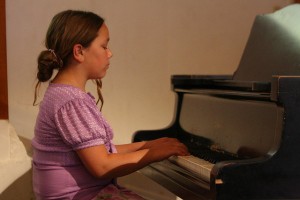As many of my students begin learning more advanced music, the same issue continues to pop up around the board. Generally they DO practice. That’s not a problem. However, they don’t always practice effectively. It’s so easy for students to just play through their piece(s) a number of times and call it a day. Unfortunately that’s not a great use of time. It’s very important for students to know how to practice effectively.
My top tips to help students make the most out of their practicing are as follows:
#1: Practice Slowly
This is very important! Everyone, myself included, loves to play pieces (even the new pieces) fast. It’s thrilling to be able to play music quickly. Usually though, students keep this fast speed on the easy parts, but pause and dramatically slow down when they get to the harder sections. This really chops up the music. If students only play through their piece over and over again from start to finish, not stopping to work on anything, everything does get better, but the harder places never make it to the same level as the easier sections. If you simply slow down, you have time to think about what you are doing and make sure you are playing everything accurately.
#2: Practice in Sections
This truly is the most effective way to practice. Take one section of the piece and play it slowly. If you play it perfectly and feel completely comfortable, go on and play the next section. If you have any hesitation or difficulty, play the section again. Keep playing it over at the slow tempo until it becomes smooth and easy for you. Once the first section has become comfortable, go onto the second section and do the same thing. After the second section is ready, add the two sections together. Work your way through the entire piece this way section by section- one section at a time and then adding them together. While this is more tedious than just playing through, this approach works miraculously. My students who follow this suggestion notice a significant improvement in their level of preparedness for lessons.
When you are practicing it’s first important to get the correct notes, rhythms, and fingerings. If you are missing any of these and practice with wrong notes, rhythms, or fingerings, it’s so much harder to try and change them later on once you’ve become used to playing the piece differently.
Next, you want to make sure you have added in all the additional details marked in the music. These include: dynamics= how loud or soft you play (piano, forte, crescendo, decrescendo, etc.), articulation= how you play a note (staccato, slur, accent, etc), and any additional markings you see. Try to notice anything notated in the music and make sure you following it.
Also, it’s incredibly important to make sure you: Pay attention to the details.
Ask yourself, “Am I missing anything?” If you are, stop and take care of it. I promise you if you take a very detailed, disciplined approach to learning your music, you will be extremely prepared for lessons. Rather than spending much of your lesson time reviewing the same piece or sections you went over last week, your teacher will be impressed, pass you on the piece or section, and you’ll move onto something new.
I highly encourage you to give these tips a try! If you need motivation to make sure you practice, check out this blog post from a couple of weeks ago where I talk about using a practice chart to help you practice.
Thanks so much for reading! Leave a comment below and tell me your best tips for effective practicing. Is there something you have tried that works really well for you? Subscribe to the newsletter and “like us” on Facebook.
Have an awesome day!
Musically yours,
Cassie

{ 2 comments… read them below or add one }
Dear Cassie
This is so wonderful because it is encouraging my kids to play piano and spent more time.
Thank you so much
Ant
You’re welcome Ant! I’m glad your kids are encouraged to play piano. 🙂